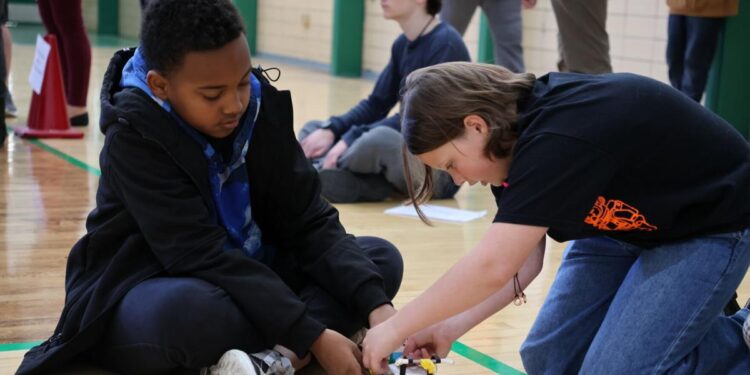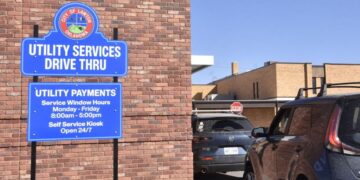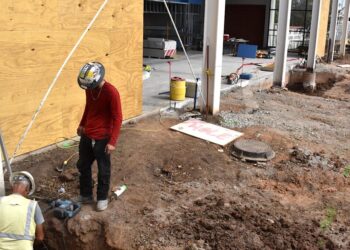Students took a deep dive into solving the problems of the ocean on Tuesday during the Lawton Public Schools/Redlegs Junior Robotics LEGO League Challenge.
Students combined research, coding and robotic skills to find a solution to a problem plaguing the ocean. First, students had to come up with a problem, research the solution and then build and code a robot to complete missions to solve the problem. Students had 2½ minutes to guide their robots through as many missions as possible, collecting points along the way. Other students made presentations about their findings to a panel of judges.
The No. 1 goal of the competition is to have fun, according to Doris Biegler, STEM coordinator for Lawton Public Schools and coordinator of the competition. Goal No. 2 is teamwork, she said.
“They get to learn from others and they learn to be teammates and partners,” Biegler said. “They are going to learn something new even if they don’t win.”
The competition also shows students that engineering and programming are not as difficult as they may think, she said. Being involved in robotics also introduces students to career paths they may not have considered.
“I can’t wait for my kids to come back and say, ‘I work for NASA’ or ‘I work for Boeing’. What a great thing for our students to be in a city that supports robotics,” Biegler said.
Lawton Public Schools fielded 23 elementary and middle school teams with five to 10 students per team. Byng Public Schools also was invited to the competition and brought about 35 students.
The problems the students created ranged from developing a technique to detect sharks in the water to cleaning up oil spills to saving vaquitas from extinction.
Jaxon Whetzel, 14, who attends Lawton Virtual Academy, said his team tackled the problem of warning about possible shark attacks.
“A teammate called up the Coast Guard to talk about shark attacks,” he said. From there, the robotics team came up with a solution of using drones to detect swim patterns of the sharks and sending an alert.
“Using the drone was our idea,” he said.
Jarrod Lovell, 10, a student at Almor West, said his team explored how to clean up oil spills by creating a filter to separate oil from water. Their solution was to use color sensors to detect the oil and then program a robot to filter the oil from the water.
Lovell said he volunteered to do the coding because he is considering a career in that field.
The Sullivan Village team decided to help out vaquitas, which is a small porpoise native to the Gulf of California.
Naomi Jenkins, 10, from Sullivan Village, said vaquitas are becoming extinct due to illegal fishing. She said her team coded a robot to detect when vaquitas are caught in nets and to cut the nets so the vaquitas can get out safely.
Some students also learned the hard lesson that not everything always works perfectly. The robot operated by the Eisenhower Generals team, from Eisenhower Elementary School, froze while doing its mission.
“The screen froze, but time went on,” Jayden Gordon, 11, said. He said his teammate started coding the robot again, but it took too long and time ran out.
“I learned to calm down and not just try to hurry up and rush because when you hurry up and rush, things can go wrong,” Gordon said.
The Lights Out team from Freedom Elementary School also experienced a hiccup. A part was stuck in their robot and they had to figure out how to remove it in time to compete.
“The part that holds the motor still is broken,” said Joshua Murphy, 11. “We will have to pull out the whole motor to fix the robot.”
“We have some time, I’m just teaching lessons,” coach Brooke Rooney said as she sat on the floor working on the robot with Murphy and Rose Brown, 9.
Part of the goal of the robotics program is to foster teamwork among the students.
Tilena Woods, 11, a member of the Lincoln Elementary School Raider Robotics team, explained in her presentation the role teamwork played in their project.
“It wouldn’t be a team without a few arguments,” she told the judges. “We figured out how to lift the robot. It was all teamwork.”
The event would not be possible without the help and support of volunteers, Biegler said. Those volunteers included about 10 Redlegs for STEM from Fort Sill, one volunteer from FISTA and some LPS administrators and staff.
One of those volunteers was Michael Anderson, who volunteered to judge the mission portion of the competition. Anderson is a former sponsor of a robot club at MacArthur Middle School and is a systems analyst in the Lawton Public Schools Media Center.
“This is my joy,” he said. “They have a lot of targets to choose from. Personally, I find it overwhelming. It’s pretty advanced for elementary students.”
Anderson said what he enjoys most is the delight of the students.
“It’s fun to do,” he said. “The kids are like a little bunch of Frankensteins getting their master to come to life.”
Want to reach a local audience and grow your business?
Our website is the perfect platform to connect with engaged readers in your local area.
Whether you're looking for banner ads, sponsored content, or custom promotions, we can tailor a package to meet your needs.
Contact us today to learn more about advertising opportunities!
CONTACT US NOW





